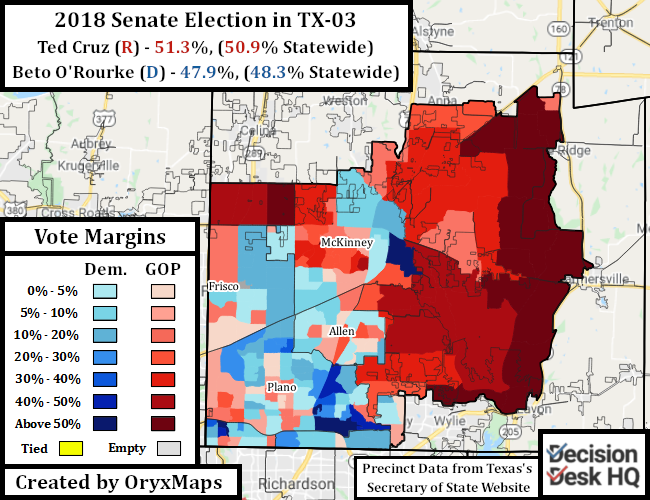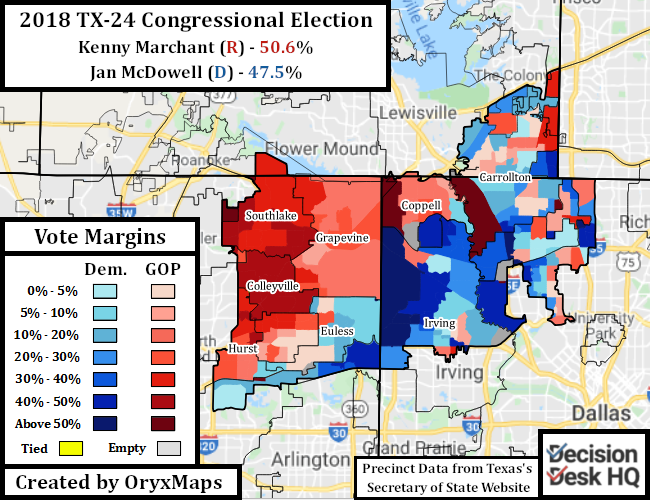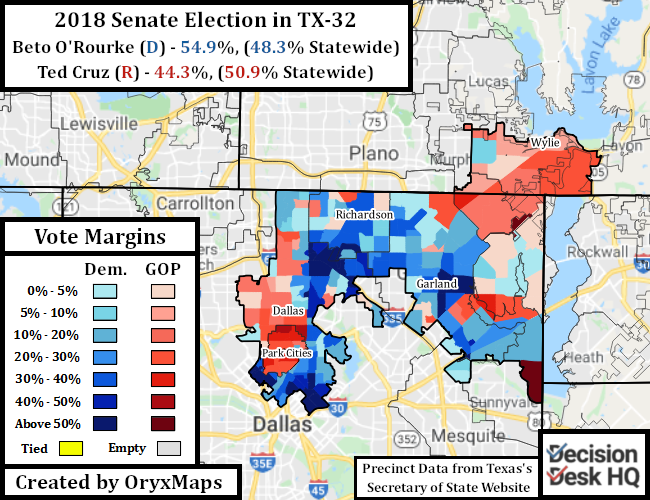Everything is bigger in Texas, including the list of battleground Congressional districts. Both parties are contesting seats in the Lone Star state, with varying degrees of success. Texas’s congressional map was not designed to be this competitive – only one seat of 36 was marginal in 2012. The Republican-controlled State Legislature carved up Democratic communities and paired the pieces with historically Republican suburbs.
The map held for four years before buckling in 2016, and then breaking in 2018. Texas gained almost four million people since 2010, mainly in the state’s cities and their suburbs. College-educated professionals continue moving to Texas, taking advantage of opportunities in the cities and the lack of a state income tax. Texas’s suburbs are now home to people of all ethnicities, not just Whites. It therefore makes sense that Hillary Clinton’s presidential ticket appealed to Texas. Clinton won three Republican-held Congressional districts and improved the Democratic position in 29.
The Republican gerrymander has become a weakness for Congressional Republicans. Robert “Beto” O’Rourke lost statewide in his 2018 Senate campaign to unseat incumbent Ted Cruz, but won 16 districts outright, lost four districts by less than the 2.6% statewide margin, and lost three districts by only a bit more than the statewide margin. If the race had been slightly closer, O’Rourke could have won a majority of Congressional districts while losing statewide. Republican strength with evangelical and rural voters concentrated their vote into 12 districts, nine of which were originally drawn to deny access to rural southern conservative Democrats.
The majority of O’Rourke’s votes transferred down to Congressional Democratic candidates–even those without significant monetary or media presence. Candidate brand and political ideology mattered only slightly; a gerrymandered seat that pairs partisan Democrat and Republican areas tends to elect partisan representatives from either party. Democrats flipped two of the three Clinton-Republican districts, and came close in eight others.
Now, these districts are battlegrounds: eight Republican districts are on the DCCC’s Red-to-Blue program, and the two seats Democrats flipped in 2018 are GOP targets. A few additional Republican seats could change hands if Biden voters remain Democratic further down the ballot. Texas polls point towards a marginal race for President, which could translate into new Democratic Congressional seats. Today’s article focuses on the four competitive districts in the immediate Dallas-Fort Worth Metroplex. Part Two will examine the competitive seats connected to Austin, and Part Three will finish the analysis with the battleground districts around Houston and San Antonio.
TX-03 (North Metroplex Suburbs)
Incumbent: Van Taylor, Republican
2016 Presidential Election: 54.8% Trump, 40.6% Clinton
2018 Senate Election: 51.3% Cruz, 47.9% O’Rourke
2018 Congressional Election: 54.2% Taylor (R), 44.2% Burch (D)
Bachelor’s degree or higher: 54.5%
Population Ethnicity: 54.7% White, 14.9% Hispanic, 9.8% African American, 17.8% Asian
Congressional Ratings: DDHQ – Lean R, Cook Political – Lean R, Sabato’s Crystal Ball – Likely R, FiveThirtyEight – Likely R

Texas’s 3rd Congressional district is the most college educated district in the country currently represented by a Republican, district 19 out of 435 according to the 2018 American Community Survey. TX-03 is additionally one of the least gerrymandered districts on a map that had no problem pairing rural ranchers and Austin hipsters. TX-03 contains about 88% of Collin Counties residents, and the district tries to neatly follow the borders of the suburban localities within the County. Collin County voted overwhelmingly Republican from 1968 to 2016, which is why Republican mappers have avoided gerrymandering the seat. Clinton’s improvement among college educated voters led to her losing the seat by a 14% margin, and O’Rourke built upon this foundation to make TX-03 a 3.4% race. Beto won the Collin County portions of Plano, Frisco, Richardson, Dallas, and barely lost Allen.
Freshman Republican Van Taylor won the 2018 TX-03 Congressional election by a 10-point margin, larger than Cruz’s victory, but significantly short of the landslides previously enjoyed by former Republican Representative Sam Johnson. Taylor now faces Democrat Lulu Seikaly, a Lebanese-American Plano-based Labor lawyer. The district got national attention in September when Seikaly released an internal poll showing her trailing by one point, an improvement from her July poll that had Taylor leading by a 6% margin. Both internals found Biden ahead of Trump within the district. Taylor released an internal poll in August that had him leading by 13 points, but he notably did not have a majority of the vote. Democrats have additionally released polls that point towards close races for Texas’s 66th and 67th State House districts. These two seats cover most of Plano, Allen and the Collin County pieces of Richardson and Dallas. Seikaly trails the incumbent in campaign fundraising, $1.1 million to Taylor’s $2.1 million. The With Honor Fund, a PAC dedicated to electing veterans to congress, is spending an additional $382K on ads to support Taylor. Seikaly notably outraised Taylor by $170K between during the Q3 campaign finance period, (July to September) after her campaign started receiving national attention. Democrats do not need to win Collin County to win TX-03, but Biden might need to carry Texas to win the district and open the door for Seikaly.
TX-06 (Arlington and South Metroplex Suburbs)
Incumbent: Ron Wright, Republican
2016 Presidential Election: 54.2% Trump, 41.9% Clinton
2018 Senate Election: 51.2% Cruz, 48% O’Rourke
2018 Congressional Election: 53.1% Wright (R), 45.4% Sanchez (D)
Bachelor’s degree or higher: 32.3%
Population Ethnicity: 45.5% White, 25.4% Hispanic, 20.9% African American, 4.8% Asian
Congressional Ratings: DDHQ – Safe R, Cook Political – Likely R, Sabato’s Crystal Ball – Likely R, FiveThirtyEight – Likely R

Texas’s 6th Congressional district is one of two seats presently competitive because Republicans chose not to draw a third Democratic district in the Dallas-Fort Worth Metroplex. It was apparent in 2010 that Grand Prairie and eastern Arlington were diversifying into extensions of safe Democratic Dallas, but the assumption then was that additional the suburbs of Ellis and Navarro Counties had enough Republican voters to nullify these trends. However, favorable growth patterns and Democratic improvement among college-educated voters led to Clinton and then subsequently O’Rourke pulling TX-06 closer to the political center. Tarrant County accounted for 71% of the votes cast in 2018, and O’Rourke won that portion of the district by a margin of 11%.
Democrat Stephen Daniel hopes that minority turnout in 2020 will increase and counter the Republican votes from Ellis and Navarro. Democrats have released two internal polls, one from July and one fielded just this week. Both found Daniel trailing freshman Republican Ronald Wright by 4%, with neither candidate crossing the 50% threshold. The issue for both candidates is that TX-06 is not a frontline seat, so it lacks national attention. The recent October poll found only 9% of respondents could say they have heard of Daniel, and only 24% had any prior opinions about Wright. Both Wright and Daniel had only about $200K on hand at the end of September, and only raised $760K and $558K respectively overall. Daniel is not on the DCCC’s Red-to-Blue program, limiting his campaign’s visibility with donors. Health issues have forced Wright, age 67, into the hospital for lung cancer treatment and pneumonia, restricting campaign visibility. The absence of attention suggests TX-06 favors the Republican incumbent, but also suggests the possibility for an upset.
TX-24 (North Dallas Suburbs)
Incumbent: Kenny Marchant, Retiring, Republican
2016 Presidential Election: 50.7% Trump, 44.5% Clinton
2018 Senate Election: 51.3% O’Rourke, 47.8% Cruz
2018 Congressional Election: 50.6% Marchant (R), 47.5% McDowell (D)
Bachelor’s degree or higher: 48.4%
Population Ethnicity: 44.6% White, 23.6% Hispanic, 12.8% African American, 15.5% Asian
Congressional Ratings: DDHQ – Toss Up, Cook Political – Toss Up, Sabato’s Crystal Ball – Leans D, FiveThirtyEight – Lean R

The comparative compactness of Texas’s 24th Congressional district belies the fact that it is just as gerrymandered as the 100-mile long districts that pair Austin with rural ranchers. Republicans refused to draw a third Democratic district in the Dallas Metroplex in 2010, and instead opted to conform to Republican incumbent Kenny Marchant’s demands. The district was drawn to include Marchant’s home of Coppell, Carrollton where he once served as mayor, the diversifying suburb of Irving, and as many conservative suburbs in Tarrant County as possible to keep the seat safely Republican. Despite the increasing diversity of Irving, it was reliably Republican in 2010 because only 25% of residents voted. Diversification and Democratic improvement among educated voters led to this district voting for Trump in 2016 by less than 6 points, before backing O’Rourke by a 3.5% margin in 2018. Marchant opted to retire rather than face a Toss Up battle for reelection.
Today, TX-24 is an electoral battle between Democrat-supporting Dallas and Denton Counties, and Tarrant County, which votes Republican. Approximately 59% of the district’s 2018 voters were from the eastern side of the district, even though the east has almost twice as many residents as the west. Beto won the eastern side of TX-24 by 58% to 41.2%, a margin twice as large as Clinton’s result two years prior in the same precincts. Some improvement can be attributed to the Metroplex’s East and South Asian communities, which are concentrated in Carrollton and north Irving. Beto lost the Tarrant County piece by 57.2% to 42%, the opposite of his victorious margin in Dallas and Denton. This piece of Tarrant County is over 60% White, and the median household income in the western suburbs is at minimum $25K more than the already well-off east. Southlake’s $230K median household income is one of highest in the Metroplex. Yet, O’Rourkes’s improvement among suburban Tarrant County voters allowed him to narrow the partisan gap, flipping the district into the Democratic column.

Democrats selected educator and Carrollton school board member Candace Valenzuela, one of several notable Democratic candidates who were attracted to the open race for TX-24. Republicans nominated Beth Van Duyne, former mayor of Irving and regional administrator for President Trump’s Department of Housing and Urban Development. Valenzuela presently has the advantage on most measurable campaign metrics. Valenzuela leads in fundraising with $3.6 million raised before October compared to $2.65 million for Van Duyne. Van Duyne has $789K on hand heading into October compared to $987K for Valenzuela. Both parties and their PACs are investing in TX-24, but Democratic aligned groups are winning the ad war with $6.2 million invested compared to the $5.6 million spent by Republican aligned PACs. Additionally, the Everytown for Gun Safety PAC has recently set aside a portion of a $2 million Texas investment for ads attacking Van Duyne in the last weeks of the campaign. District polling data is outdated, but it also favors Valenzuela (only Democratic groups and a term limits lobbyist group released results). Biden is currently polling similar to Beto O’Rourke’s 2018 campaign in Texas statewide polls, which suggests that the Democratic ticket could carry TX-24 in November. Van Duyne therefore needs to hope for a favorable crossover vote, similar to the electorate that reelected Marchant in 2018.
TX-32 (Dallas and North Dallas Suburbs)
Incumbent: Colin Allred, Democrat
2016 Presidential Election: 48.5% Clinton, 46.6% Trump
2018 Senate Election: 54.9% O’Rourke, 44.3% Cruz
2018 Congressional Election: 52.3% Allred (D), 45.8% Sessions (R)
Bachelor’s degree or higher: 45.3%
Population Ethnicity: 46.5% White, 27% Hispanic, 14.9% African American, 8.1% Asian
Congressional Ratings: DDHQ – Lean D, Cook Political – Likely D, Sabato’s Crystal Ball – Likely D, FiveThirtyEight – Likely D

Democratic freshman Colin Allred is favored to win reelection because the entirety of Texas’s 32nd Congressional district is subject to same demographic and political trends making Texas competitive. The exclusive Park City enclaves of Highland Park and University Park, along with the wealthy Dallas neighborhoods to their immediate north, were supposed to be what kept TX-32 Republican even if the rest of the district moved towards the Democratic column. Yet, Democratic gains among affluent and educated voters weakened Republican margins in this district’s west, allowing Clinton to carry TX-32 with her strength in the diversifying eastern suburbs. Favorable growth patterns, diversification in places like Garland (which today is less than 40% White), Democratic improvement among educated voters, and the anti-Trump backlash in urban and suburban areas pushed TX-32 into electing Allred in 2018. These same trends continue to be present in 2020, except now Allred is the incumbent, and Biden is poised to carry the seat at the top of the ticket.
Republicans are sticking with the coalition that originally controlled TX-32. Genevieve Collins grew up in Highland Park and is the head of corporate strategy at Istation, an education technology firm chaired by her father Richard H. Collins. Collins has tried to walk the path between appealing to hot button Conservative issues, while distancing herself from the Presidential brand that appears to be losing TX-32. Yet in 2018 Allred outperformed Clinton’s 2016 margin and only underperformed Beto O’Rourke’s margin by 2.6%, suggesting that Republicans cannot outrun Trump’s disapproval in Dallas. Collins was one of the first Republican challengers added to the NRCC Young Guns list, yet she trails Allred in fundraising. The Democratic incumbent has so far raised $5 million and has $1.7 million on hand. Collins has raised $4.6 million, $1.4 million of that through personal loans, and has only $1 million on hand. Democrat insiders believe the seat to be off the immediate battlefield, which is why they have only dedicated $137K in outside ads compared to the $580K from the GOP and their aligned groups. It seems unlikely that Collins will outrun Trump by enough of a margin to flip TX-32, which is why the seat favors the Democrats.
Part Two will be available on Thursday
Ben Lefkowitz (@OryxMaps) is a Contributor to Decision Desk HQ.